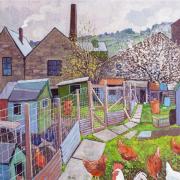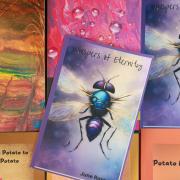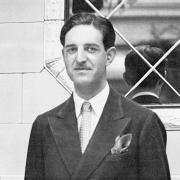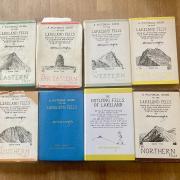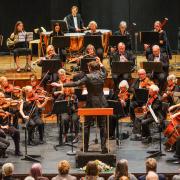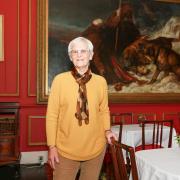The Holcombe Hunt dates back to Norman times but it has only ever had two female Masters. Doreen Crowther met the lady in red, Sue Simmons
It is not difficult to spot Sue Simmons when she is riding with the Holcombe Hunt. She is the lady in red.
This vivacious mother of two young sons is the Master of the Hunt, only the second woman in its history to hold this title. Members voted for her last year and it means she can dress as the men in what is traditionally known as pink - thought to be a reference to Thomas Pink, the London outfitter - while the women wear black with a red trimmed collar.
It is quite an achievement considering the thriving Holcombe, one of the oldest hunts in the country, can trace its roots to 1086. Even the hounds can boast an aristocratic lineage.
They are believed to be directly descended from a breed called the Blue Gascoignes, which were brought across the Channel by the Norman invaders.
Sue is the sole Master of Holcombe, unlike many hunts which have more than one to share the duties, and she combines this with a busy business and home life. Sue has two full-time jobs - she’s financial director of Simmal Limited, of Bamber Bridge, a family business of aluminium stockholders and fabricators and she’s a housewife looking after husband John and sons Alistair, nine, and William, seven,
They live in the Samlesbury area and Sue’s passion for horseriding is obvious. She’s a former finalist at the Horse of the Year Show and loves equestrian sports. She enjoys competing and has a young horse, stable name Ricky, that she plans to compete in the Hunter Class. Its show name, Golbers Hill, is based on a place in Devon where her husband grew up.
When the hunting ban was introduced in 2005, Sue recalls, it had a huge impact on hunts nationwide. ‘Everyone involved was afraid for the future of the heritage of hunting,’ she says. Although she doesn’t accept the cruelty arguments, Sue emphasises that the Holcombe Hunt operates within the law. Ironically, since the ban more people than ever are following the hunts around Britain.
Despite this she believes all the hunting community is still reunited in hoping the ban will be repealed but she admits it’s far from certain even if a Conservative government is elected. ‘The process that will have to be gone through is a big mountain to climb,’ she says. ‘There would have to be a free vote within the House to repeal the ban. And they would have to go through various stages. But I would welcome a repeal.
‘We had a Farmers’ Ball recently with 650 guests and my personal view is that the countryside still supports hunting and is keen for it to go ahead.
The overriding aspect to the hunt is that farmers, prior to the ban, used the hunts as a service to control the fox population on their land. They would still like that service and in the old days we were able to provide that service for free.’ Whatever happens, Sue stresses, the Holcombe Hunt will operate within the law.
She questions the contention that the ban has made following the hunt more popular. She argues: ‘Unless you interview every person, how can you make that assumption? Drag hunting -following an artificial trail - has always existed. People have always been able to choose to go on a trail hunt. You don’t know whether people are in agreement with traditional hunting or whether � they are only hunting with you because it is now trail hunting. I would like to think they are supporters of traditional hunting.’
Holcombe members vote for their Master and there is no set period for Sue’s time in office. Her duties include the running of the hunt, which encompasses ensuring that the hounds are professionally cared for. The Holcombe has a professional Huntsman, Steven Ashworth who looks after 40 hounds - or 20 couples, as they are known.
The kennels are at Kirklees in Bury and have been there for nearly 100 years. Before that, they were in Holcombe 200 years. With her team, Sue has to ensure that the hunting calendar is in place for the season and
a summer calendar is available. This latter is essentially for parading hounds in shows, attending competitive hound shows and staging social events for the hunt members. A large part of her work is liaising with farmers and landowners. On the days when the hunt meets, Sue is the Field Master and rides in front of the mounted followers and shows them the way and it is her job to know which fields the hunt may cross. The Holcombe country extends from arable farms near Southport, over grasslands in mid Lancashire and onto the East Lancashire moors.
While recognising that the hunt has to have a modern outlook, she appreciates that most people enjoy the old traditions, which surround hunting. She is addressed as Master, the horn is still blown even though the hounds are following a trail instead of a fox. ‘There are still people out there who want to hang on to their heritage,’ she says.
The hunt welcomes newcomers and on specific days will ‘buddy’ them with an experienced rider so they are not left to fend for themselves. ‘People are very honest about their own abilities,’ she says. ‘Some will say they found the experience quite tough or they felt they did well and ask to come again. And we are keen to promote people’s enjoyment of the cross-country element of the sport.’
Hunt meets last up to four hours depending on the time of year, the weather and ground conditions. They have specific children’s meets and on those days they welcome 50 or 60 youngsters. ‘Holcombe is very much a family hunt. It is unique in this day and age that everyone can be involved together. We have had children at the age of two coming,’ Sue says.
Vote in the poll or leave a comment below.





